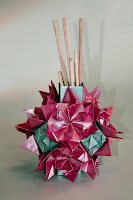In between my other tasks I have continued to develop a large scale modular vase. It has lots of box pleats which I can use to shape the final product. I have got as far as putting together the bottom of the three major sections. Like the other sections, it is made up of eight other sections, if you don't count the "plug" to cover the central hole. The result, with a little modification of the parts which will later be used to connect the middle section, is a large dish.
There will be no edges showing in the final product. All the seams are hidden in the box pleats which are locked by the square foldings at the intersections. Although they look like square twists, these ones are not actually twisted. Once you know the secret of producing them they are not as impossible or as slow to collapse as you might think. Mind you, it took me a lot of trial and error and lateral thinking before I found a relatively easy way to make them. I shall eventually reveal all, so keep your bookmark or your feed subscription current.
 This is a photo of the prototype base section. The central plug had not been added at this point.
This is a photo of the prototype base section. The central plug had not been added at this point. 
This prototype has been folded from graph paper. There are a number of advantage to using graph paper in the early stages. Folding is faster when you do not have to find all crease lines in relation to previous folds and landmarks. Changes are easier to track. Transferring the creases to a master pattern is facilitated.
I am working on a conventional folding plan so that the model can be folded without the need for a printed guide. This is important because the top sections of a full sized jar use paper which is too large to be put through a normal printer. Besides, the need to print out CPs restricts the type of paper which can be used.
It is too early to provide diagrams or CPs. First, this is just the base section. Second, the model may go through several more changes before I am satisfied with its shape, locking mechanisms and ease of folding. I will post updates as I fold them.
I expect to be tied up with other rather time-consuming matters for several more weeks so postings will be a little more spaced out than the hectic activity in recent weeks. If you want to follow the vase through its development then consider subscribing to the RS feed. There is too much of interest on the Net to waste your time coming back here each day just in case you miss the next exciting installment.










































